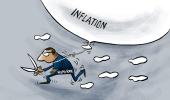The uneven monsoon in 2023 means that the sugar industry is already beginning to factor in a drop in production in Maharashtra, Karnataka and Gujarat.
Sanjeeb Mukherjee reports.

The last few years have been uncharacteristically good for the Indian sugar sector for a variety of reasons.
While on the one hand, the weather supported good crop production; on the other hand, the programme to blend ethanol with petrol took off in a big way.
The long-pending problem of burgeoning sugarcane arrears almost came down to nil and exports boomed to record highs.
The notorious cyclicality associated with the sugar sector that for many, was the genesis of all the problems almost vanished.
A decade ago, the cyclicity of sugar production had been the bane of the Indian sugar sector.
Generally, 3-4 years of higher production were followed by a drop in sugar production for 1-2 years.
In the years of surplus production, there were glutes leading to a crash of domestic prices resulting in the accumulation of cane price arrears of farmers.
Due to the delay in getting payment, the farmers felt demotivated to plant sugar cane in subsequent years, resulting in lesser cane availability and, thereby, a drop in sugar production.
The prices further jumped, and mills' liquidity improved, leading to clearing of cane dues in time, prompting farmers to increase their cultivation area.
And the cycle moved accordingly.
Since the 2010-11 sugar season (October to September), the problem of cyclicity in sugar has been considerably reduced, and the industry has been continuously producing surplus sugar more than domestic requirement.
In the past 10 years, sugarcane and sugar production has reduced only in 2016-17 season due to adverse effects of drought in two major sugar-producing states of Maharashtra and Karnataka.
Ethanol blending
The rejuvenation of the ethanol blending programme was a big plus for the sugar sector, improving the cash flow and enabling mills to clear cane dues accruing to farmers faster than before.
According to a report of the Parliament Standing Committee presented very recently in 2013-14 sugar season (October to September), mills earned around Rs 1,368 crore from ethanol which by the end of 2021-22 season had jumped to almost Rs 21,000 crore, a mind-boggling increase of nearly 1435 per cent.
The proactive approach of Oil Marketing Companies (OMCs), along with differential pricing of various grades of ethanol and subsidised loans to add fresh capacities, ensured that while sugar companies supplied just 3.8 crore billion litres of ethanol in 2013-14, by the end of 2021-22 season this number has jumped to almost 44 billion litres.
The blending, too rose from 1.53 per cent in 2013-14 to almost 10.02 per cent in 2021-22, and by the end of 2022-23 season in the next few months, it will touch 12 per cent.
The diversion towards ethanol meant that in 2018-19, India produced 0.33 million tonnes of less sugar which rose to 4.3 million tonnes by the 2022-23 season.
Exports
Not only was blending booming, but even exports had also looked up in a big way.
Data shows that in the 2017-18 sugar season, just around 0.62 million tonnes of sugar was exported, which in the 2021-22 season had jumped to an all-time high of 11 million tonnes.
In the ongoing 2022-23 season before it was stopped, India exported around six million tonnes of sugar.
Farmers also gained
The twin projects of ethanol blending and higher exports meant that whatever surplus was there in the system got absorbed, and farmers got paid on time.
In the 2017-18 sugar season, sugar FRP was Rs 255 per quintal for an average recovery of 9.5 per cent, which rose to Rs 305 per quintal for an average recovery of 10.25 per cent.
The states that gave their own SAP, namely Punjab, Haryana, UP, and Uttarakhand, the increase was even higher.
In Punjab, between 2017-18 and 2022-23 seasons, the SAP rose from Rs 300 a quintal to Rs 380 per quintal, while in UP it rose from Rs 315 to Rs 350 a quintal.
More importantly, sugarcane dues completely vanished, and per the government's statement in Parliament between 2018-19 and 2021-22 almost 100 per cent of sugarcane price payable to farmers has been cleared.
The new variety helped
The fact that India consistently produced surplus sugar could also be attributed to the wonder variety called Co-0238, developed by award-winning plant scientist Bakshi Ram.
Co-0238 not only gave a higher per-hectare yield than the existing sugarcane varieties but also had a higher sucrose content.
So, while the former benefited the farmers, the latter gladdened the heart of millers.
Higher sugarcane yields, according to an analysis by ICAR meant that farmers in UP earned almost Rs 62,000 per hectare more purely by using Co-0238 in some years, while for the millers, the recovery went up by nearly 1.2-2.0 per cent.
In no time, Co-0238 captured the imagination of the ordinary sugarcane farmer in Uttar Pradesh, lured by higher per hectare return, and he scrambled to plant the same variety.
Higher recovery also meant that Uttar Pradesh went on to become India's largest sugar-producing state surpassing Maharashtra.
The good times coming to end
But, as with all fairy tales, the Indian sugar sector's bull run is also poised to face some challenges in the coming years.
Starting from the weather, the uneven monsoon in 2023 means that industry is already beginning to factor in a drop in production in Maharashtra, Karnataka and Gujarat.
The three states accounted for almost 17.5-18 million tonnes of sugar out of the total production of around 33 million tonnes in 2022-23 (nearly 54 per cent).
Weak rains in these states could lower sugarcane yields by at least 20 per cent, some industry players said, which would not be fully compensated by an increase in production in Uttar Pradesh, which is another big producing state.
A drop in cumulative sugar production would mean that diversion of juice towards ethanol would become all the more challenging, and if ex-mill prices rise to over Rs 37-39 per kg, mills would be tempted to make more sugar than divert it towards ethanol.
Presently, ex-mill sugar prices average all India is around Rs 36.
Lower diversion towards ethanol could jeopardise the much-cherished target of 20 per cent blending with petrol by 2025.
Low sugar production would also mean that exports are totally out of question for now, as any increase in domestic sugar price would compel the government to prioritise domestic availability over exports, particularly in an election year.
Also, being an election year, most states where SAP is applicable, namely UP, Punjab, Haryana and Uttarakhand, might increase the rate to ensure that farmers are kept happy.
This could impact the margins of mills, particularly in UP which is home to the biggest sugar mills in the private sector.
And finally, the sugarcane recovery is also under threat as the wonder sugarcane variety of Co-0238, which many experts believe to be a big reason for India becoming surplus in sugar is increasingly facing a challenge from red rot and other deadly diseases.
Overall, after many good years, India's sugar sector is again staring at multiple challenges.
How it negotiates them, only time will tell.
Disclaimer: This article is meant for information purposes only. This article and information do not constitute a distribution, an endorsement, an investment advice, an offer to buy or sell or the solicitation of an offer to buy or sell any securities/schemes or any other financial products/investment products mentioned in this article to influence the opinion or behaviour of the investors/recipients.
Any use of the information/any investment and investment related decisions of the investors/recipients are at their sole discretion and risk. Any advice herein is made on a general basis and does not take into account the specific investment objectives of the specific person or group of persons. Opinions expressed herein are subject to change without notice.











